Bulletin – May 2009 Fundamentals, Portfolio Adjustments and the Australian Dollar[1]
- Download 223KB
Introduction
After reaching a post-float high against the US dollar in mid 2008, the Australian dollar depreciated sharply, declining by almost 30 per cent in a two-month period from late August 2008. Although this was the sharpest depreciation in the post-float era, the adjustment was consistent with the evolving global economic situation. Similar adjustments in the Australian dollar have occurred in previous economic cycles, such that the floating exchange rate has been a stabilising influence on the economy over the past few decades (Debelle and Plumb 2006). In this article we review how the exchange rate responds to changes in economic fundamentals in the long run and how, in the short run, flows related to portfolio and balance sheet adjustments by financial institutions can be useful in explaining sharp movements in the exchange rate.
Even though general economic developments are useful in understanding the long-run cycles in the exchange rate, on a day-to-day basis market commentators often discuss exchange rate movements in terms of the balance of supply and demand for Australian dollars among the various participants in the foreign exchange market. This includes the foreign exchange flows of importers and exporters, investors such as superannuation and hedge funds, central banks, financial intermediaries and foreign exchange dealers. Some of these participants, especially foreign exchange dealers and ‘macro’ hedge funds, are particularly attentive to new public information about economic developments, such as data releases, and therefore their trades play an important role in ensuring that the exchange rate adjusts to changes in macroeconomic fundamentals. However, many of the flows through the foreign exchange market, such as those relating to trade or long-term foreign investments, are not generated directly in response to the latest news about economic fundamentals, but rather reflect the specific transaction needs of market participants for foreign exchange at that time.
In particular, financial institutions generate significant foreign exchange flows as part of managing the foreign currency exposure on their balance sheets or the portfolios they manage on behalf of others. For example, fund managers that hedge at least some of the currency exposure of their foreign equity portfolios generate large flows in the foreign exchange market as they adjust the hedge position in response to changes in the underlying value of their portfolios. Similarly, other participants, such as hedge funds, generate flows when they use currency positions as a hedge or proxy for investment positions in other markets.
Fundamental Drivers of the Australian Dollar
Historically, it has been possible to explain broad movements in the Australian dollar exchange rate by considering two important economic fundamentals, namely the terms of trade (which typically move in line with global commodity prices) and the differential between domestic and foreign interest rates. Strong world growth tends to put upward pressure on commodity prices and the terms of trade; this strengthens the outlook for returns on Australian dollar assets and increases the demand for Australian dollars from exporters, which is usually reflected in an appreciation of the exchange rate. Similarly, all else equal, strength in the domestic economy relative to the rest of the world tends to be associated with a larger interest rate differential, which also acts to appreciate the exchange rate.
The relationships between the terms of trade, interest rates and the exchange rate can be reasonably well captured in simple econometric models.[2] However, these models do not imply that there is a mechanical causal relationship from, say, the terms of trade to the exchange rate. Rather, each of these variables is a price (or some aggregated measure of prices) that will respond to market participants' changing assessment of economic fundamentals. Foreign exchange market participants are efficient at incorporating new public information, meaning that news about the economic outlook affects the exchange rate at least as quickly as it affects commodity prices and interest rates owing to changes in expectations for future economic growth.[3] Indeed, the nature of some of Australia's important commodity export markets, such as bulk coal and iron ore, are such that new information is incorporated in these prices with a significant lag, well after it is captured in the exchange rate.
Although the short-term relationship between fundamentals and the exchange rate has not always been a precise one (Macfarlane 2000), it nevertheless was not surprising that there was a sizable adjustment in the exchange rate in late 2008 as the outlook for world growth rapidly deteriorated with the intensification of the global financial crisis. The swift pace of the reassessment regarding the global growth outlook – the IMF cut its forecast for global growth in 2009 by 2½ percentage points to only ½ per cent between October 2008 and January 2009 – goes some way towards explaining the sharpness of the depreciation in the Australian dollar. In line with weakening global growth, commodity prices fell sharply in the second half of 2008, and the differential between Australian and foreign interest rates declined as it became increasingly evident that Australian growth would be weighed down by the global weakness (Graph 1).
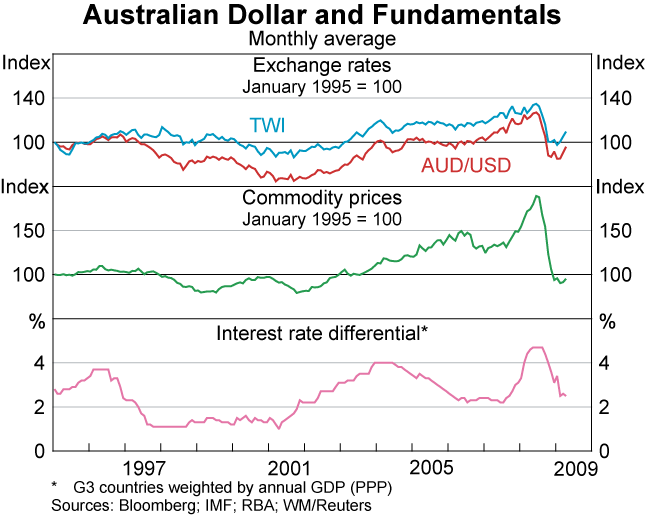
Portfolio Adjustments and the Australian Dollar
Notwithstanding the significance of fundamentals, it appears that portfolio and balance sheet adjustments have been more important for the behaviour of the exchange rate than in the past, particularly on occasions of extreme intraday volatility. Some of the sharpest intraday moves in the exchange rate in the recent period occurred at times when there was no specific new information about either the global or the domestic economy. Rather, market commentary often attributed these sharp movements to one-sided flows generated by balance sheet and portfolio adjustments in response to developments in other financial markets. These flows were also reported to be contributing to the deterioration of liquidity in the spot foreign exchange market, with the best bid-ask spread widening significantly between September and November 2008 (Graph 2).[4]
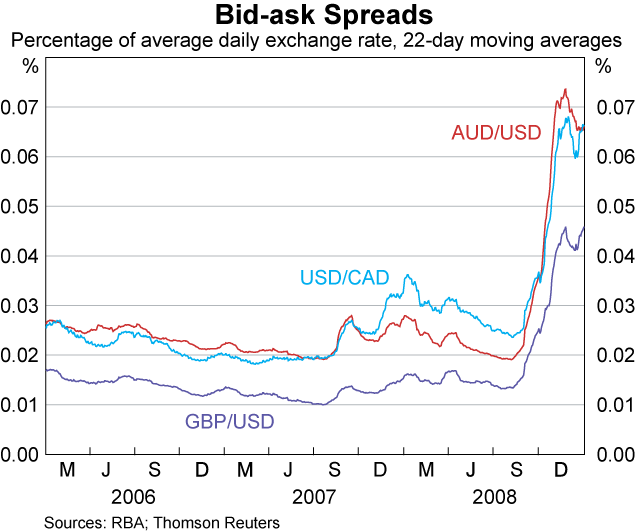
Anecdotal reports of unusually large balance-sheet-related flows in the foreign exchange market are supported by the turnover data published on a semi-annual basis by the five major Foreign Exchange Committees.[5] Spot and forward turnover grew strongly in aggregate across the major financial centres between April and October 2008, with AUD/USD turnover also experiencing positive growth (Graph 3). This is in comparison to a reduction in turnover in a number of other financial markets, such as equities and bonds. However, as discussed in Debelle, D'Arcy and Ossolinski (2009), turnover of foreign exchange swaps fell significantly as this segment of the market became dislocated as a result of increased counterparty risk.
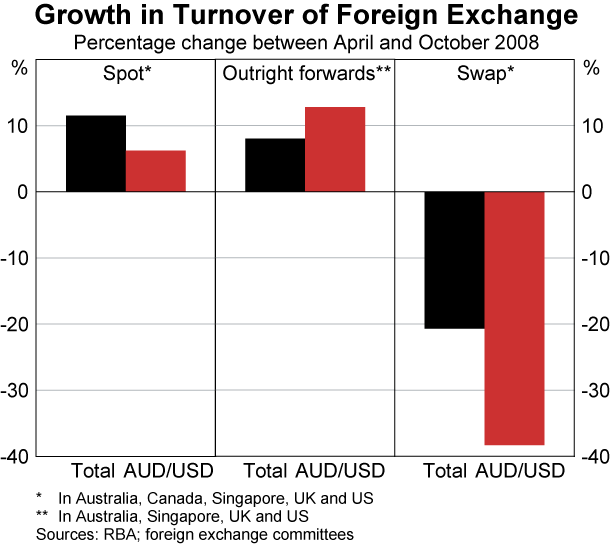
The potential significance of balance sheet and portfolio adjustments for the exchange rate has increased considerably in the past decade in line with the growth in international financial flows. This can be seen by examining the growth in gross size of the combined external assets and liabilities of Australia, the United States, the United Kingdom and Japan (Graph 4). The foreign exchange flows generated by adjusting these positions will be most significant when they are driven by a common shock that causes a large number of investors to simultaneously behave in a similar way – there have been a large number of such shocks during the course of the current global financial crisis. The remainder of the article explores three types of portfolio adjustments that are reported to have affected the Australian dollar during the period of financial market volatility in the second half of 2008.
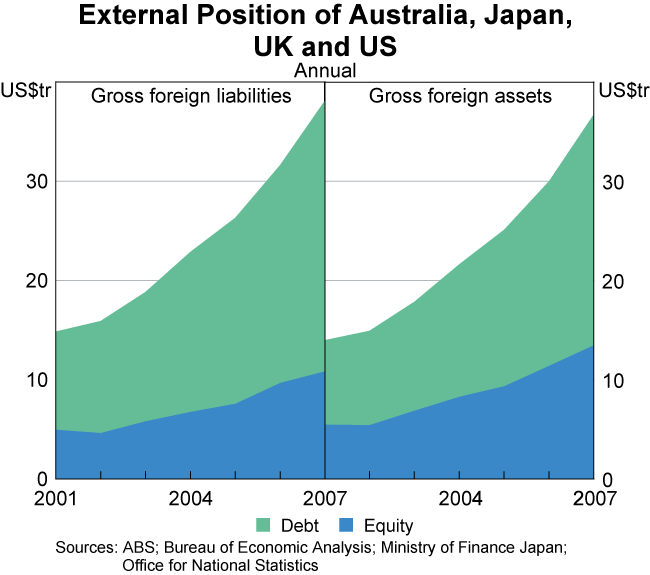
Risk retrenchment and deleveraging
One portfolio effect that is believed to have had a significant impact on the Australian dollar during the course of the current financial crisis is changes in the willingness and capacity of financial institutions to hold risk, often referred to by market commentators as ‘risk appetite’. The large losses and extreme volatility across many financial markets, greater economic uncertainty and contraction in credit availability during the financial crisis have led to an increase in the quantity of risk relative to the capacity and willingness to hold risk. Consequently, many financial institutions have endeavoured to reduce risk in their portfolios. The Australian dollar is historically more volatile than many other developed economy currencies and highly correlated with global growth, and therefore is typically viewed as having a relatively high level of measured risk by portfolio managers, so that episodes of risk retrenchment have been associated with selling the Australian dollar.[6] One indication that fluctuations in risk appetite have been affecting the Australian dollar is the high correlation between the AUD/USD exchange rate and US equity markets (Graph 5).
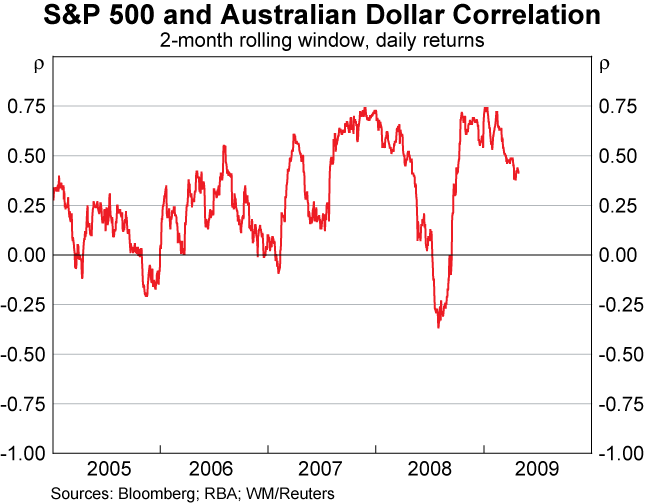
In addition, leveraged investors that experienced losses and were forced to liquidate assets to cover margin calls are likely to have sold the most liquid assets in their portfolios. Given that Australian financial markets continued to function well relative to many overseas markets during the episodes of extreme financial market disruptions, investors may have found it easier to liquidate Australian dollar assets than assets denominated in other currencies, suggesting the Australian dollar may have been more affected by these types of flows than other currencies.
A specific example of portfolio adjustment relating to leveraged positions involved the unwinding of carry trades. On several days when the largest falls in the AUD/USD occurred there was large-scale selling of the Australian dollar against the Japanese yen. These flows were attributed to investors unwinding carry trade positions that had become unprofitable given the sharp depreciation of the AUD/JPY exchange rate. Investors in carry trades exploit the short-run failure of uncovered interest parity, that is, they expect that movements in the bilateral exchange rate will not offset returns from the interest rate differentials that exist between countries. Although there are a variety of ways in which investors can gain exposure to the carry trade, the return on such trades is composed of two components – the interest rate differential, which is typically small and stable, and the change in the exchange rate, which is typically larger and more volatile (Graph 6). The sharp depreciation of the Australian dollar in response to the deteriorating global outlook saw the negative exchange rate return vastly outweigh the small positive interest rate differential leading investors to close out their carry positions, placing further downward pressure on AUD/JPY, resulting in another wave of carry trade unwinds and so on.
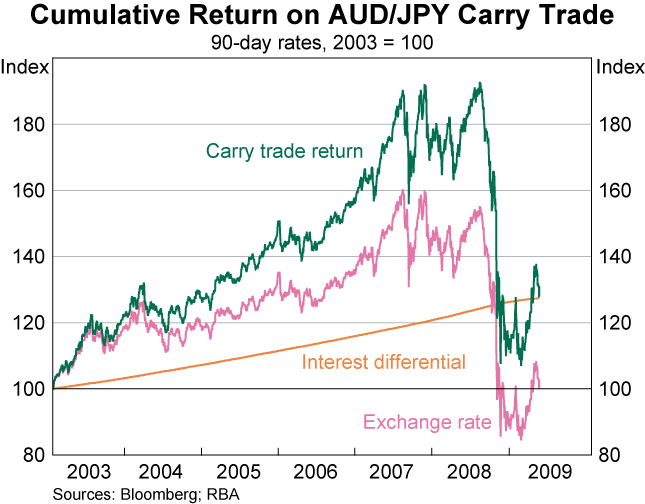
It is very difficult to quantify the aggregate size of outstanding carry trade positions and therefore the size of the flows that could have resulted from the unwinding of these positions.[7] However, using data on two subsets of carry trade investors – Japanese retail investors and speculative traders at the Chicago Mercantile Exchange – Zurawski and D'Arcy (2009) show that these investors rapidly liquidated their large carry trade positions around the time that the depreciation in exchange rates began to affect the profitability of their positions. Extrapolating the behaviour of these carry trade investors to the broader group of carry trade investors active in the foreign exchange market suggests that flows associated with the unwinding of carry trades were very large in August 2007 and October 2008.
The adjustment of hedges by Australian fund managers
On several occasions since the onset of financial market turbulence there have been reports of large flows associated with Australian fund managers reducing the size of exchange rate hedges on foreign equity portfolios. Surveys conducted by the ABS and nabCapital estimate that Australian non-bank financial institutions with large foreign assets, primarily managed funds, hedge the exchange rate exposure on between one-third to one-half of their foreign equity portfolios, with the percentage hedged increasing between 2005 and 2007 as the Australian dollar appreciated.[8] Fund managers hedge this exchange rate exposure by purchasing Australian dollars in forward markets and rolling these hedges as the forward contracts mature. This procedure locks-in the exchange rate and will deliver investors a return close to the foreign currency return on the foreign equity investment plus the interest rate differential (Graph 7). However, hedging the exchange rate exposure of foreign equity portfolios is inherently more complicated than hedging international debt investments, as the size of the hedge needs to be adjusted in line with the movements in the value of the underlying portfolio. In particular, the size of the hedge becomes too large (small) when the value of the underlying portfolio falls (rises). Portfolio managers typically adjust the hedge size monthly, but may increase the frequency of adjustment when equity markets are more volatile.
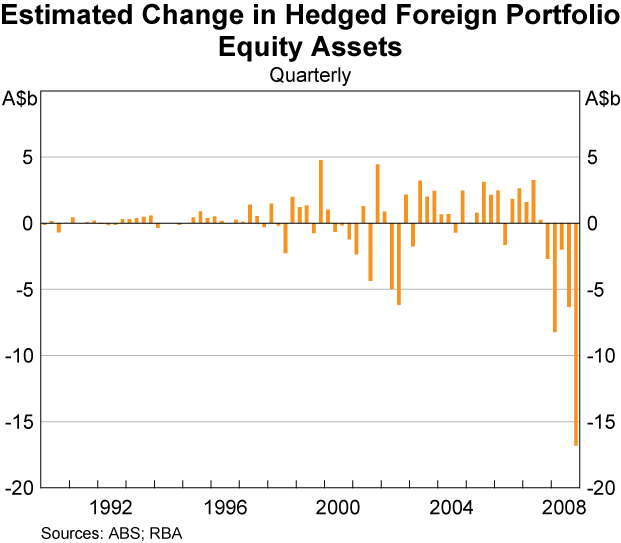
September and October 2008 saw large declines in global equity markets, which reduced the size of underlying foreign equity portfolios. The reduction in underlying foreign currency exposure resulted in foreign portfolios being over-hedged. In order to correct the hedge fund managers could immediately enter into an offsetting trade to sell Australian dollars forward, thereby causing the Australian dollar to depreciate. Even if the fund manager chose to keep the original hedge open until it expired, they would receive more Australian dollars upon the maturity of the forward leg than needed to roll the hedge. In this event, sales of the Australian dollar in the spot market would cause the Australian dollar to depreciate.
Data on customer flows from at least one major domestic foreign exchange dealer do indicate that domestic real money investors (which include fund managers with hedged foreign equity portfolios) were significant sellers of Australian dollars in October 2008. This is despite official balance of payments data on financial flows suggesting that Australian investors were actually repatriating foreign equity investments in the second half of 2008, which would imply purchases of Australian dollars. The fact that real money investors appear to have been net sellers of Australian dollars suggests that the flows associated with the unwinding of hedges were significantly larger than those associated with the repatriation of foreign equities by Australian investors over the period when the Australian dollar was depreciating.
One possible caveat on the unwinding of currency hedges on foreign equity portfolios as an explanation for downward pressure on the exchange rate is that the same behaviour by foreign investors in Australia, in response to similarly large declines in the value of Australian equities, would generate offsetting flows in the Australian dollar market. However, although there is no direct evidence on the currency hedging behaviour of foreign investors in Australian equities, it seems likely that they are largely unhedged. Data from the 2005 hedging survey indicate that in aggregate foreigners hold net long positions in Australian dollars, suggesting foreigners are willing to hold Australian dollar risk. Moreover, Australian assets represent only a small share of global assets and international investors typically seek Australian dollar assets as a way of gaining exposure to the global growth and commodity cycle and are therefore unlikely to hedge the currency exposure of Australian investments to the same extent that Australians hedge the currency exposure of their foreign equity investments.
The use of currencies as proxies
The global foreign exchange market is one of the most liquid financial markets in the world. Even during the turbulence of October 2008, when liquidity was drying up in other markets, the major currency pairs continued to be tradable 24 hours a day, albeit at somewhat higher spreads than previously. This made currency markets a source of liquidity for investors wishing to take new positions (including ‘hedges’ designed to offset existing positions) in markets that became untradable or were expected to experience large movements when they re-opened.
One reported use of the Australian dollar during the financial market turbulence in late 2008 was as a proxy for emerging market currencies and assets. Emerging market currencies are typically only traded during the local market session, and even when their markets are open they are significantly less liquid, and therefore more expensive to trade, than the markets for major currency pairs. For example, very few trades of Latin American currencies, such as the Brazilian real (BRL), against the US dollar occur between AEST 8 am and 8 pm whereas the Australian dollar is typically traded around the clock (Graph 8). In contrast, emerging Asian currencies such as the Malaysian ringgit (MYR) and Korean won (KRW) are only traded in the Asian and early London sessions between AEST 10 am and 8 pm. Assuming a high correlation exists between the Australian dollar and the emerging market currency in question, the Australian dollar could be used as a proxy to either protect the investor against ‘gaps’ that occur upon the re-opening of the market, or to adjust positions in markets that have lost liquidity and are expensive to transact in.
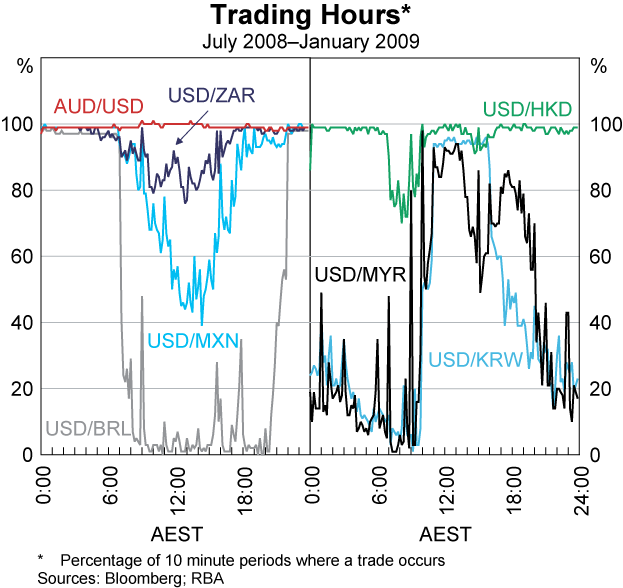
Taking the USD/BRL as an example, the correlation between movements in the AUD/USD and USD/BRL while the Brazilian real market was shut reached high levels in September and October 2008 (Graph 9). This co-movement is not surprising as the Australian dollar and Brazilian real are both viewed as ‘commodity currencies’ owing to Australia and Brazil's large commodity exports, and therefore respond in a similar way to news regarding the outlook for world growth and commodity prices. The period of time when the USD/BRL market is shut is also a period of time when the AUD/USD market is more liquid than other potential proxy currencies such as the USD/CAD and NZD/USD that also have a strong correlation with commodity prices. The Australian dollar could also have been used as a proxy for commodities that lack a liquid futures market, such as iron ore, or are predominantly traded on specific exchanges that are not open 24 hours, such as the London Metal Exchange.
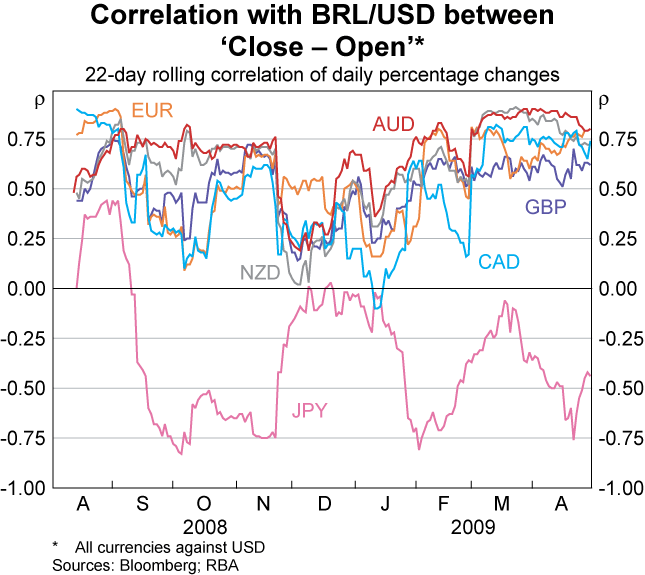
Conclusion
While deteriorating macroeconomic fundamentals were primarily responsible for the large depreciation of the Australian dollar since October 2008, on several occasions large flows related to portfolio and balance sheet adjustments by investors contributed to volatility and illiquid conditions in the spot foreign exchange market. This article examined three of these types of flows: flows associated with risk retrenchment and deleveraging such as the unwinding of carry trades; the adjustment of hedges by Australian fund managers; and the use of currencies as proxies for other assets. Importantly, all three of these flows were in the same direction – selling Australian dollars – exacerbating the existing downward momentum of the exchange rate generated by the evolving economic fundamentals.
References
ABS (Australian Bureau of Statistics) (2005), ‘Foreign Currency Exposure’, ABS Cat No 5308.0. Available at <http://www.abs.gov.au/AUSSTATS/abs@.nsf/DetailsPage/5308.0Mar%202005>.
Becker C, G Debelle & D Fabbro (2005), ‘Australia's Foreign Currency Exposure and Hedging Practices’, RBA Bulletin, December, pp 1–8. Available at <http://www.rba.gov.au/publications/bulletin/2005/dec/pdf/bu-1205-1.pdf>.
Clifton K and M Plumb (2008), ‘Economic Data Releases and the Australian Dollar’, RBA Bulletin, April, pp 1–9. Available at <http://www.rba.gov.au/publications/bulletin/2008/apr/pdf/bu-0408-1.pdf>.
Debelle G, P D'Arcy and C Ossolinski (2009), ‘Recent Conditions in the Australian Foreign Exchange Market’, RBA Bulletin, March, pp 9–18. Available at <http://www.rba.gov.au/publications/bulletin/2009/mar/2.html>.
Debelle G and M Plumb (2006), ‘The Evolution of Exchange Rate Policy and Capital Controls in Australia’, Asian Economic Papers, 5(2), pp 7–29.
Galati G, A Heath and P McGuire (2007), ‘Evidence of Carry Trade Activity ’, BIS Quarterly Review, September, pp 27–41. Available at <http://www.bis.org/publ/qtrpdf/r_qt0709e.pdf>.
Gruen D and J Wilkinson (1991), ‘Australia's Real Exchange Rate – Is it Explained by the Terms of Trade or by Real Interest Differentials?’, RBA Research Discussion Paper No 9108. Available at <http://www.rba.gov.au/publications/rdp/1991/9108.html>.
Macfarlane IJ (2000), ‘Recent Influences on the Exchange Rate’, RBA Bulletin, December, pp 1–6. Available at <http://www.rba.gov.au/publications/bulletin/2000/dec/pdf/bu-1200-1.pdf>.
Poole E and P D'Arcy (2008), ‘Liquidity in the Interdealer Foreign Exchange Market’, RBA Bulletin, December, pp 1–6. Available at <http://www.rba.gov.au/publications/bulletin/2008/dec/1.html>.
Zurawski A and P D'Arcy (2009), ‘Japanese Retail Investors and the Carry Trade’, RBA Bulletin, March, pp 1–8. Available at <http://www.rba.gov.au/publications/bulletin/2009/mar/1.html>.
Footnotes
This article was prepared by Patrick D'Arcy and Emily Poole of International Department. [1]
Econometric models with this basic structure have a long history. For an early example see Gruen and Wilkinson (1991). [2]
Clifton and Plumb (2008) model the response of Australian dollar to US data releases. [3]
See Poole and D'Arcy (2008) for a discussion on indicators of liquidity in the interdealer market. These spreads are calculated using best-order and trade data for the Reuters Dealing 3000 electronic interdealer broking platform. These data are supplied by the Securities Industry Research Centre of Asia-Pacific (SIRCA) on behalf of Reuters. As these data are subject to a publication lag, the liquidity indicators in this article are available only up to end December 2008. [4]
Australia, the United States, the United Kingdom, Canada and Singapore produce semi-annual turnover surveys. Japan reports on an annual basis and is therefore not included in this analysis. [5]
Market liaison often indicates that the trades of some participants in the foreign exchange market are ‘model-driven’. Given that the correlations in the historical data suggest the Australian dollar is a good ‘barometer’ for risk appetite, model-driven traders typically sell the Australian dollar when measures of financial market volatility increase. [6]
Although they are not able to quantify the size of carry trade flows, using the BIS international banking statistics and foreign exchange turnover data Galati, Heath and McGuire (2007) provide some evidence of carry trade flows increasing prior to 2008. [7]
See Becker, Debelle and Fabbro (2005) and ABS (2005) for more details on Australia's foreign currency exposure and hedging practices. The nabCapital Superannuation FX Survey was conducted in 2002, 2005 and 2007. [8]